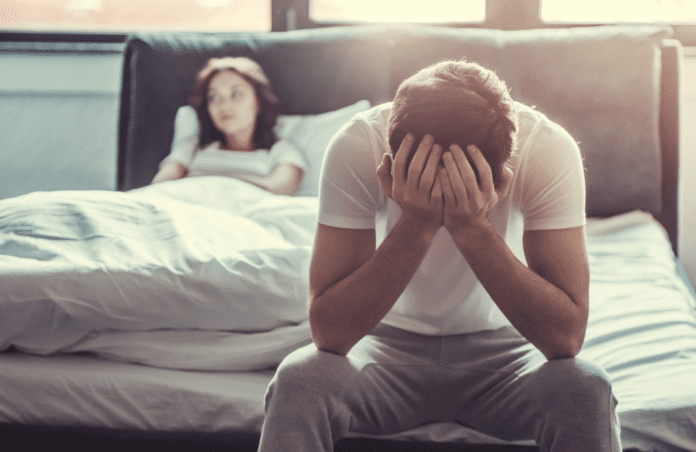When we think of sexual dysfunction, what likely comes to mind is erectile dysfunction (ED) in men. However, there are different kinds of sexual dysfunction, and they can affect both men and women. Sexual dysfunction disorders fall into four categories:
- Desire disorders: These disorders affect sexual desire and interest in sex, and they are also known as libido disorders or low libido. Low estrogen and testosterone levels can cause decreased libido, as can hormonal changes, medical conditions (like diabetes and heart disease), relationship problems, sexual inhibitions, fatigue, fear, depression, and anxiety, among other things.
- Arousal disorders: These disorders make it difficult or impossible to become physically aroused during sexual activity. The most common type in men is ED. When a person has an arousal disorder, they may be interested in sexual activity, but they are unable to receive physical satisfaction from it.
- Orgasm disorders: These involve the absence of orgasm or delayed orgasm; they are a common problem for women, but they can also occur in men. Pain during sexual activity, stress, fatigue, hormonal changes, and reduced libido can all lead to delayed or absent orgasm.
- Pain disorders: These involve pain during intercourse and can affect both men and women. For women, pain may be caused by vaginal dryness, vaginismus (a condition that affects the vaginal muscles), urinary tract infections (UTIs), hormonal changes during menopause, and other conditions. In men, pain may be caused by Peyronie’s disease (physical damage to the penis), infections like UTIs, prostatitis and yeast infections, genital herpes, and skin conditions.
Unlike ED, very few people have heard of what doctors call female sexual interest/arousal disorder (FSIAD). This condition can present as a lack of sexual desire, a lack of physical arousal, or both. FSIAD is common, with about 40% of women experiencing some type of sexual dysfunction in their lives.
Also Read: The 5 Most Common Female Sexual Problems & How To Treat Them
It is usual for women to have fluctuations in sexual desire throughout their lives, but a significant or total loss of interest in sex, or difficulty responding to stimulation, may indicate FSIAD. While it is frustrating, it is fully treatable.
Read on to learn more about the symptoms and available treatment options.
Signs and Symptoms of Sexual Arousal Disorder
FSIAD is more common in women over the age of 45 – which makes sense since symptoms are often similar to what women notice when their hormone levels are low during the menopause transition. These symptoms include:
- Lack of sexual desire/losing interest in sex
- Few thoughts related to sex
- Decreased sexual arousal or pleasure during sexual activity
- Reduced or no arousal in response to visual, written, or verbal cues that once worked
- Less or no sensation in the genitals and erogenous zones
- Lack of vaginal wetness and lubrication
- Pain during intercourse
- Inability to orgasm
- Reduced vaginal dilation of the blood vessels, which is necessary for the lubrication
- Decreased genital swelling with arousal
- Less initiation of sexual activity and feeling unreceptive to a partner’s attempts to initiate sex
Also Read: 11 Tips On How Erectile Dysfunction Can Ruin Your Mental Peace & Relationship
The Causes of Sexual Arousal Disorder in Women
There is a multitude of reasons that women may be suffering from FSIAD, but the most likely causes for the disorder include:
- Decreased and depleted hormones, specifically estrogen, progesterone, and testosterone. Hormones are a necessary part of maintaining vaginal tissue health. Low hormones can result in vaginal tissue that is dry and thin, leading to painful intercourse. It makes sense then that arousal problems can accompany low hormone levels. Birth control pills and pregnancy also change hormone levels, leading to sexual disorders.
- Psychological and emotional factors like depression, anger, stress, and relationship problems.
- Reduced blood flow to the genital area. The body’s circulatory system must be fully functional to be properly stimulated. By increasing blood flow to the genitalia, sexual arousal can be restarted.
- Nerve damage to the pelvis.
- Vaginal infections, which are more common with age as hormone levels drop.
- Drug use (prescribed or illicit) including SSRIs and chemotherapy can lead to dysfunction.
- Some people are asexual. It is important to note that FSIAD is different from asexuality, which is not a medical condition.
Treatment
Treatment for FSIAD focuses on identifying and addressing the underlying causes, so medication, therapy, or both might be the solution. Many women find that a combination of treatments seems to work best. Depending on the case, hormone replacement therapy (HRT) or a blood-flow enhancing medication may be appropriate. The following are steps to take for approaching treatment:
- Check to see if hormone therapy is an option. If the underlying cause is hormonal, HRT can supplement low estrogen and testosterone to treat vaginal dryness and pain during intercourse.
- Look into a genital vasodilator that stimulates the clitoris to increase blood flow in a similar way that viagra helps men with ED.
- If a medication like an antidepressant is causing your symptoms, adjusting your dosage may help.
- Consider a therapist who can help you identify what barriers are getting in the way and offer guidance on building trust and intimacy with your partner, which can play a significant role in arousal.
Summary
FSIAD is a type of sexual dysfunction that affects many women and can manifest as low sexual desire and/or lack of physical arousal. FSIAD can be discouraging and frustrating, but there are treatments available that can help.
If you have signs or symptoms of any type of sexual dysfunction, talk to your doctor. Many factors can contribute to FSIAD, so someone might benefit from several treatment approaches including HRT, vasodilators, and therapy.
See your gynaecologist today or visit a healthcare provider and find a treatment plan that is right for you.


